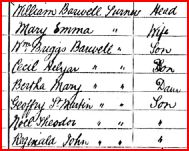
More than a microscopist: remarks on the life and work of William Barwell Turner (1845 – 1917)
Peter B. Paisley
Sydney, Australia
Also in doc file format where A4 printing layout retained.
William Barwell Turner was born in Birmingham on 8th June 1845. His lifelong professional occupation lay within the English brewing industry. His father, Thomas Turner, is described in the 1841 census simply as an “agent”, living with his wife Sarah and a maidservant in Victoria St. Birmingham: perhaps significantly, a publican, John Rohathan, lived a few houses away. Whatever the case, by 1851 the Turners, now with their 5 year old son William Barwell Turner, and a different maidservant, lived at 99 Obyse St., still in inner Birmingham, and by now Thomas was described as a brewer’s agent. William was a pupil at King Edward’s Grammar School, so a good primary education, perhaps involving appreciable expense on books, was assured for him. His interest in microscopy almost certainly began there – the microscope was widely recommended as an educational tool in Victorian schools, and in many popular works as a vehicle for intellectual (and moral) improvement at home, to illustrate the infinite ingenuity of a benign creator.
In Obyse St., next door to the Turners, lived William Barwell, “a proprieter of houses”, and he probably owned the Turner house: Thomas Turner married his daughter Sarah, and their son William Barwell Turner was named after him. The Barwells were up and coming capitalists: in 1851 William’s son Joseph was a warehouseman, but by 1861 the census has him as an accountant, living with William in Obyse St. (now in a different house), and also close by in Obyse St., there was John Barwell, also “a proprietor of houses” and probably related to William. William Barwell’s daughter, Sarah – and her only son William – doubtless benefitted from his financial help when it was needed. One need look no further than William Barwell Turner’s children for evidence of deeply felt bonds between the families. Every one of W.B. Turner’s six offspring bore the middle name Barwell: a fact so widely known, apparently, that the Yorkshire Weekly Post hyphenated the name in their obituary appreciation of William.

The Turner family in 1891, from the census.
Many technical pursuits were recommended for nineteenth century domestic amusement, combined with instruction: widespread fascination with a range of “philosophical” matters is vividly illustrated on the title page of John Badcock’s (ca.1820) work, illustrated below.
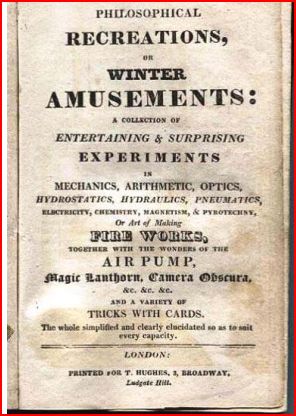 By
the time William Turner was at school twenty years later, such
“philosophical” hobbies were widespread, including home
chemistry experiments. And by the time he was in training as a
brewer, an explosion of new knowledge was under way, bringing
together chemistry and microscopy, first for the wine and beer
industries (and soon for medicine.)
By
the time William Turner was at school twenty years later, such
“philosophical” hobbies were widespread, including home
chemistry experiments. And by the time he was in training as a
brewer, an explosion of new knowledge was under way, bringing
together chemistry and microscopy, first for the wine and beer
industries (and soon for medicine.)
A ferment of new knowledge
For aeons, the phenomena of fermentation attracted opposing theories: the central question was, did spontaneous generation explain it? That idea had been around, often along with quasi evolutionary notions, at least since the pre-Socratic philosophers. The opposite side of the coin – putrefaction – could be viewed as life ebbing away, with fermentations as examples of a flood of new spontaneous life. Until improved lenses offered visualisation of micro-organisms, the evidence we now take for granted was out of reach. Pasteur’s discoveries therefore, suddenly, provided means for dissolving centuries of speculation. Decomposition could now be seen as a vigorous expression of life, not death, and fermentations as products of similar basic processes. Given the value to the French wine trade of Pasteur’s work, the beer industry in England could not ignore the microscope as an industrial and economic tool, nor did it, although it was somewhat sporadic in recognising its worth. By 1889, microscopy was well enough entrenched in brewing for Matthews and Lott, for instance, to regard it as de rigeur for trainee brewers: as they say in their preface to their “The Microscope in the Brewery and Malt-House” (dedicated to Pasteur),
In these days when there are few breweries which do not possess a Microscope, it would seem desirable that the instrument should not fall prey to the casual or uninstructed observer, but should rather, by the knowledge and skill of those who use it, be made a means of controlling the processes of Malting and Brewing.
William Barwell Turner’s work personifies that attitude, but his range of microscopical interests extended far beyond brewing. He was making mounts by 1860, and possibly before that. The selection of slides illustrated below conveys some idea of his scope.
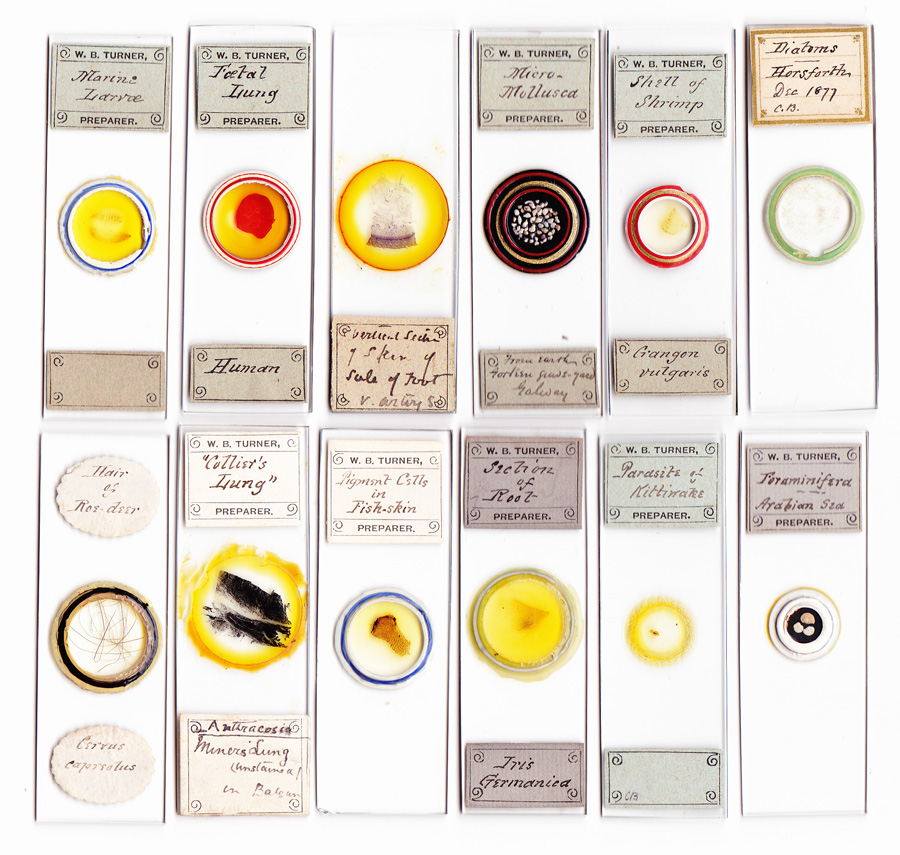
Turner slides, showing subjects ranging from diatoms to human pathology. His diverse interests, far from fully illustrated here,
extended well beyond the malt-house.
Mounting styles
Many Turner slides bear his distinctive printed labels, which he may have designed himself, since he was a good draughtsman. Most labels bear neat printing in a readily recognisable hand; a few, particularly on the lower labels, bear his “running” writing. Slide size adheres to the 3x1 inch formula, but slight irregularities are frequent, so Turner probably cut his own glass. Typically, mounts are unpapered, but many papered examples occur. Lack of dating often makes evaluation problematical, but ceteris paribus most papered mounts can be assumed to be earlier productions. His unpapered mounts are usually, but not invariably, ringed: this ranges from simple gloss black to attractive multicoloured examples, and the accuracy with which the latter are applied reflects pride in presenting professional finishes. Sometimes printed labels were not to hand, and labelling employed whatever was available. Overall, much of his output rivals the best commercial productions.

A selection of papers used by Turner: their patterns will be
familiar to collectors.
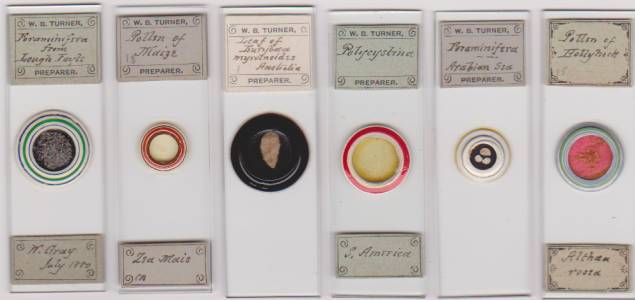
Turner ringing, from plain to polychromatic.
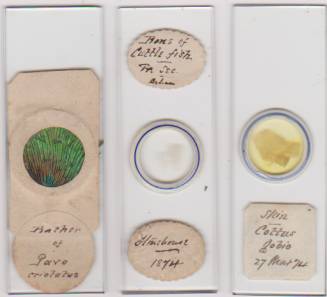
Improvisation – labelling with whatever came to hand.
Early days
Turner’s very name seems to destine him for the brewing trade. His father Thomas was a brewers’ agent: not far from Obyse St., inner Birmingham had a Jeremiah Turner, a retail brewer, at 1&2 Upper Gough St., and a John Turner, a publican, at 34 Park Lane. I have been unable to discover whether either or both were related to Thomas, but they may have been. Whatever the case, William’s father was in a position to inform the boy of career possibilities in brewing, and to instruct him on technical and business matters. According to William’s obituary eulogy in the Yorkshire Weekly Post, by 1861 he was training with Allsopp and Sons in Burton-on-Trent. He learned his trade well, since by the age of 25, the 1871 census lists him as a brewery manager.
Turner’s obituary appreciation says,
Although born in a town, he was practically brought up in the country, in contact with all the wonders of nature.
The same source states that his father was a keen sportsman, and that William learned to shoot at the age of 9: both seem to vanish from the 1861 census, which could be explained by a shooting trip when the census was taken. So where were they? Was William on holiday on his own, between school and commencing training as a brewing chemist? Or was he with his father, who combined a holiday with some business activity?
I cannot supply definitive answers to those questions, however the earliest Turner slides in my collection are dated 1860, from Aldeby, a small town on the Norfolk/Suffolk border. It may be significant that just across the border in Suffolk lay Beccles, a town with a celebrated brewery run by Harwood & Co., possibly within Turner senior’s agency ambit. Whatever the circumstances, William was at Aldeby, collecting and mounting aphids from various trees and plants. Insects were common foci of interest for young naturalists, and William was clearly interested in different micro-habitats of the types of aphids found. The most sensational new best-seller in England at this very time was Darwin’s Origin of Species, which has a lot to say about insects: from Turner’s later writing, it is clear he was committed to natural selection as a mechanism to explain variation in micro-organisms.
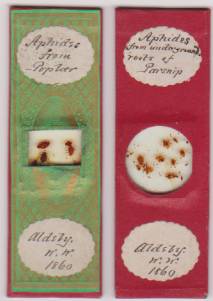
Two aphid mounts: not perhaps as sophisticated as Turner’s
later presentations, but pretty creditable for a lad in his mid
teens.
This may have been Turner’s first visit to East Anglia: there may have been more, to the Walsingham estate at Merton, and I shall say something on this presently. My 1860 slides all bear the initials “WW” on their lower labels: my best guess is that they stand for Waveney Wood, and indicate where the specimens were gathered.
Burton-on-Trent: who was training and who was trained?
While with Allsopp & Sons, William joined the Burton-on-Trent Volunteer Force in 1862. Any field exercises would have extended more opportunities for observation of nature. In addition, his father’s occupation as a brewer’s agent may have taken him on more country visits, with young William along to learn trade lore – and more about nature. Burton-on Trent, famous for its water qualities and a major centre for big beer magnates, was prominent in the application of chemical knowledge to brewing, and Turner learned advanced techniques there. The first definite evidence for use of a microscope by any Burton firm was not until 1869/70, by Horace brown at Worthington’s, and not until the mid 1880s at Allsopps. Of course, it is possible that well before that, the firm had employees who used microscopes from time to time. What can be said without doubt is that they had a trainee chemist – William Barwell Turner – who was with them for 5 years until 1866, and who was already a competent microscopist. Alsopps may have trained Turner as a chemist, but I suggest he probably contributed to training them in microscopy. Turner’s collection included a slide of puccinia graminis – the wheat rust blight, something of obvious interest to brewers. In 1865, Chemical News, a publication familiar to the big brewers like Allsopp & Sons, favourably reported on Henry Webb’s mounts, and the same Birmingham preparer gave a major communication on blights to the Birmingham Natural History and Microscopical Society in 1866, whose meetings Turner may have attended. As he later informed the Leeds Naturalists' Club, he had many Webb slides, dating back to 1860.
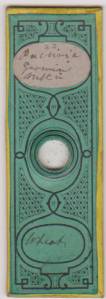
A Webb wheat rust blight slide from Turner’s cabinet
In short, Turner, even as a teenager, may have been as useful to Allsopps as they were to him. If so, the relationship was bearing fruit by the 1880s, when serious microscopical studies were occurring there, as exemplified by the photomicrographs shown below.
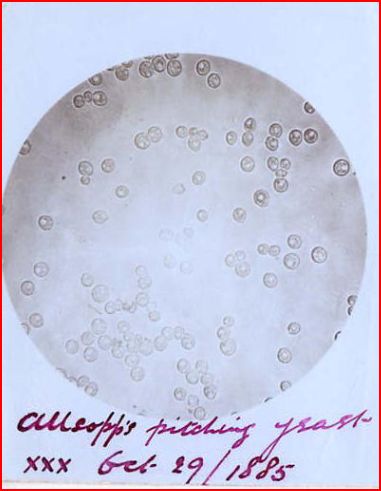
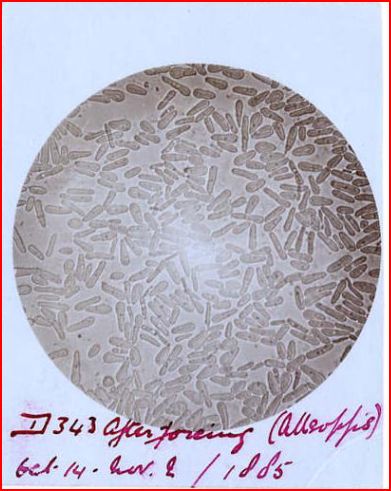
Micrographic yeast studies, probably by George Harrow, assistant to Peter Griess. Illustrations kindly supplied by Raymond Anderson.
Peter Griess came to England just after Turner left Allsopp’s: if Turner contributed to the firm with microscopy, his work may have influenced Griess. A large concern like Allsopp & Sons would have been a good addition to any young brewer’s curriculum vitae, the more so if it became known that new skills were involved in addition to chemical expertise. The plethora of Turner’s consultancies which followed his time at Allsopps seems to bear witness to this.
The roving expert
Following training with Allsopp & Sons, and now presumably qualified as a journeyman brewer with specialised chemical skills, he embarked on a series of contracts with provincial brewers, taking him as far afield as Devon, Oxfordshire, Staffordshire, Somerset and Wales. In the mid nineteenth century the big conglomerates had not yet swallowed up the hundreds of small breweries which existed all over the UK (although that process was gathering momentum), and reputations could be built for independent individuals through word of mouth via brewers’ business networks. One of Turner’s contracts took him to the Watlington brewery in Oxfordshire, and from there he embarked on at least two more visits.
The obituary appreciation makes no mention of Wales, but his sojourn there is interesting. The 1871 census shows him at Elizabeth Walters’ lodging house, 18 Hamilton Terrace, Milford. Described by directories of the time as “the most genteelest municipality in Wales”, Milford was a far cry from Turner’s childhood in grimy industrial Birmingham.
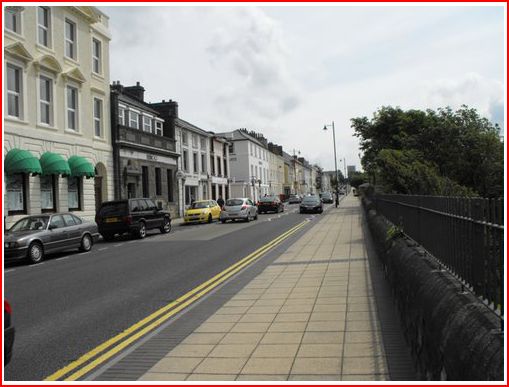
Hamilton Terrace, Milford, today: not much changed externally since Turner’s time there in 1871.
Another occupant of the lodging house was Ernest Dayrolles, a brewer and malster born in Ireland: just up the street at no.24 lived William Vaughan Williams, a brewer and wine and spirit merchant. Dayrolles and Vaughan Williams were in partnership: a chemist, Thomas Williams, was at no.21. Given another chemist in the same street, it seems possible that Turner – now a brewery manager – was negotiating to become a Dayrolles/Vaughan Williams senior executive. Also in Hamilton Terrace were Mark Palmer, a brewer (also born in Ireland), and Simon Johns, another wine and spirit merchant. A better connected environment for an up and coming young brewery manager is difficult to imagine. The rest of the street was replete with retired naval officers and various other individuals listed as “of independent means” - a possible future in the comfortably affluent town must have seemed an idyllic prospect for an erstwhile Birmingham lad. The Dayrolles/Vaughan Williams partnership did not last, however, and was listed in the London Gazette as dissolved by the following March. While based at Watlington, Turner embarked on another consultancy, this time in Somerset – a visit which proved more significant.
The west country: beer, romance and natural history
Somerset and Devon evoke cider as a favoured drink, and beer must have faced stiff market opposition there. Many small west country breweries existed nevertheless, affected by variable consumer pressure from time to time: the Bruton brewery in Somerset exemplifies this. Founded around 1630 as an almshouse enterprise, the brewing works were replaced in the eighteenth century for a lengthy period as a silk mill, but then re-converted for brewing in 1853, with John Jones as master brewer. John’s son Thomas had joined him in the business as a brewer by 1871: evidently the concern was thriving, but most small English breweries (and many large ones) were slow to employ full time chemists. William Turner’s expertise led him there, as it did to so many other locations.
Turner went to Bruton - little more than a village, where he may have been accommodated by the Jones family, who lived close by the brewery. As things developed, beer chemistry was not Bruton’s only attraction. Turner met Jones’ daughter Mary Emma there. After the Bruton visit, Turner left for Staffordshire, but Mary Emma was not forgotten – Turner returned to Somerset to marry her in 1877. She probably shared his interest in natural history: voluminous slide production, presumably carried out at home after the Turners settled in Leeds, was hardly something welcome to a wife without some mutual enthusiasm: and she must have been aware that Turner had been involved with mounting at least since 1860. Relatively few Turner slides are dated, but those below (and two already shown) were made during his courting days, before he went to Yorkshire and around the time he was in Staffordshire. Moths and butterflies were common objects of attention for many young people, and Turner’s interest in the cinnabar moth shown below went beyond overall appearance, to include its scale morphology. The selection below shows not merely a wide spread of subjects but, as evidenced by the distinctive printed label, indicates an enthusiast who already took microscopy seriously and intended making many more mounts.
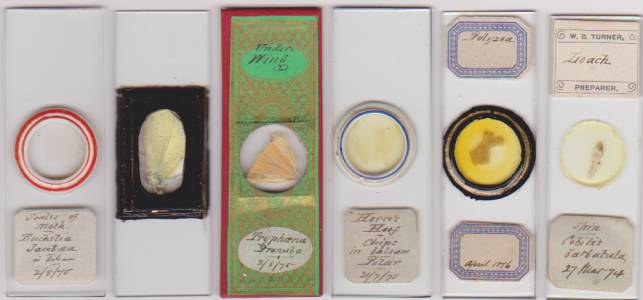
Some slides from Turner’s courting days.
Burton-on-Trent training may have left comparatively little time for natural history: but from 1866 onwards his peripatetic career through country breweries took him through a wide range of natural environments, extending opportunities to enlarge his knowledge of natural history. Excursions through the countryside would have been easier for an independent consulting chemist with flexitime than for a shop floor employee. The late slides illustrated below are not those of someone whose focus was ever confined to fermentation chemistry and microorganisms, and reflect lasting interest in general botany.
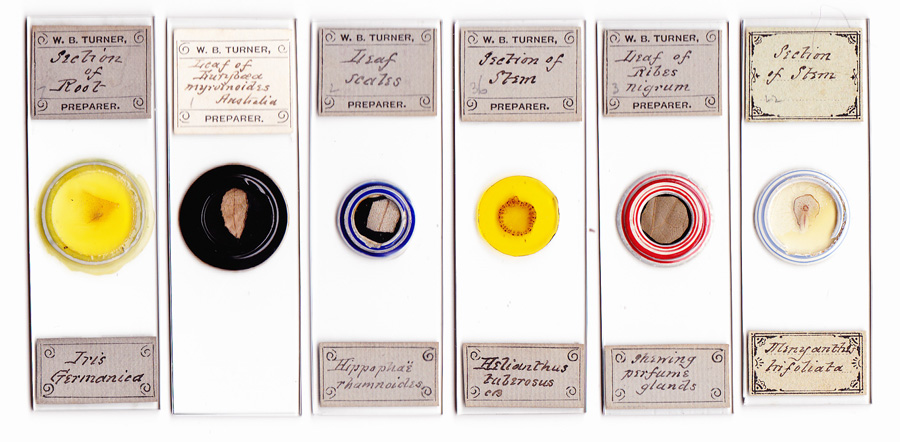
Turner mounts featuring botanical subjects remote from brewing and
microbiology.
Some brewing magnates valued microscopical expertise for its commercial potential, but many had little direct interest in matters much beyond yeast, starches and microbes. That said, the more scientifically inclined companies could have been impressed by microscopists with all round versatility, such as Turner. After all, knowledge of (for instance) the biology of hop plants was of potential value to beer makers.
Turner as slide collector
Slides made by many well known commercial mounters (and some not so well known) found their way into Turner’s cabinets, and collection probably started in his teens. Such slides would serve multiple ends: admired for their intrinsic merit, they also provided hints on technique, and added to Turner’s knowledge of particular subjects. The slides from his collection shown below once more illustrate Turner’s range of interests - only the Porter hippuric acid example relates to his activities as a professional chemist, and then pretty remotely as far as brewing is concerned. At times, as in the Topping shell and Webb beard below, Turner added his own stickers: while I cannot prove it, I also believe he ringed the Stevens slide shown.

Many commercial “big names” entered Turner’s
collection.
Given Turner’s large mount output, it is likely that from time to time he supplied slides to friends and colleagues, but I have found no evidence he was ever a commercial maker. Perhaps his knowledge of the prowess of makers like the Toppings and the Normans served to check any such hubris, or perhaps it never occurred to him to sell. Many if not most of his slides vie with those of the “professionals” in quality, so most likely he was too busy with other priorities to consider parallel business as a mounter. The fact that he is annotated but not illustrated in Bracegirdle’s Microscopical Mounts and Mounters reinforces that view.
Beer, and chemistry, under the microscope
We may not now associate beer with academic study, except perhaps during nostalgia for undergraduate days. In the nineteenth century however British brewing fostered combined chemical and microscopical research. Pasteur’s microbiological work for a French wine trade facing potential ruin was at first slow to influence British beer magnates, and “pure” chemistry was likewise slow to percolate traditional brewing craft skills, so full time chemists were tardy in infiltrating British brewing firms, which often relied on roving consultants like Turner: microscopists were at first rarer still. Anything which improved the art of brewing however aroused interest: when improved lens technology brought microorganisms under scrutiny, microscopy increasingly influenced brewers, and those like Turner with dual expertise became increasingly important. The Chemical Society of London was formed in 1841, and the profession always had strong links with brewing: by 1876 a few English brewing chemists (among them Peter Griess, mentioned previously) in Burton-on Trent had formed “The Bacterium Club”, whose title made an obvious point. Brewers’ contributions to chemical knowledge were frequent: Turner was elected FCS in 1879, duly reported in vol. 35 of the Journal of the Chemical Society. His work found its way into the Journal of the Chemical Society, Journal of the Society for Chemistry and Industry, and the Chemical news and Journal of Industrial Science, for instance. Evidently he was renowned enough for the English Mechanic (vol.42) to credit him with a doctorate – perhaps an understandable assumption, but a degree he did not have.
A generation or more before Turner, another brewer had become a microscopy enthusiast: John Nokes Furze was prominent in the Microscopical Society of London in the 1840s and 50s. Mounts from his slide collection are well known, but evidence seems to be lacking that he made his own, although that seems not unlikely. He wrote papers on the use of polarized light, and on fermentation, and was active in the chemistry and technology of brewing. Turner at some stage must have become aware of him, and perhaps his example provided inspiration.
Other developments too brought microscopy and chemistry together: in 1852, one of William Herapath’s students in Bristol had observed striking patterns in chemically treated dog urine, observed under the microscope by polarised light. An explosion of interest in all manner of chemical compounds followed, creating something of a bonanza for commercial slide mounters and polarizing apparatus makers. Smith and Beck for instance issued their “urinary series”, and firms like the Normans produced a wide range of chemical slides.
The career brewer
In 1876, Turner’s career took him to the small Yorkshire coal mining town of Woodlesford (now part of greater Leeds). It was home to Bentley’s Yorkshire Bitter, and the brewery owner Henry Bentley, as chairman of the Yorkshire Brewers’ Association, was an influential figure: Turner by this time must have been a “catch” for any employer. The Bentley firm also owned the Brunswick brewery in Leeds, where Turner moved a year later. By now he was well established in reputation and experience, in a position to marry and settle down with a family and an assured good income.

Dark satanic mills! The Woodlesford brewery, and others Turner visited, dominated rural landscapes.
Yorkshire, and Leeds, remained Turner’s home for the rest of his life. By 1884, his expertise and experience gave him the confidence to set up as an independent consultant, as a brewery valuer and consulting analytical chemist. Takeover business was now brisk in the brewery world, so his services as a valuer must have had a ready market. He also obtained a seat in the Leeds Corn Exchange, where, as a grain broker, he could expand his income.
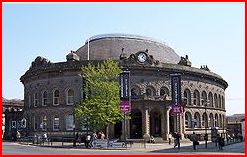
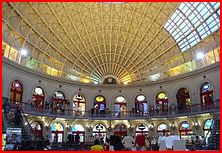
Victorian splendour: the Leeds Corn Exchange, now restored, with the interior converted to a shopping centre. Turner’s seat was at no.8.
Sport and insects
In the 1881 census, Turner quotes among his qualifications the somewhat whimsical “A.A. (Oxon)”. Neither a degree nor a fellowship, this refers to an athletics association. Which recalls his time at Watlington - the obituary describes him as “an athlete in moderation”. Turner was interested in, and in later life devoted much time to, heraldic research, wherein one of his many contacts was the sixth Baron Walsingham. His obituary appreciation , in this context, lists some of his
…..many friends – Lord Walsingham, for instance (though sport had its part in this)
In England, “sport” tends to mean “killing creatures”, and Turner’s skills with firearms may have taken him to a game bird shoot on the Walsingham Norfolk estate. Walsingham was a noted authority on game shooting. Alternatively they may first have met, via athletics, in Oxford during Turner’s time at Watlington: the Walsingham family had property and strong historical affinities with Oxford. Either and both are possible. Their friendship however surely involved more than sport and heraldry: Walsingham became an FRS and a noted lepidopterist, amassing some 260,000 specimens, ultimately donated to the Natural History Museum. His life span coincided almost exactly with that of Turner, who made many insect and butterfly mounts, a few of which are shown below. I also include a slide of pheasant parasites, which may be relevant to the Turner/Walsingham sporting friendship.
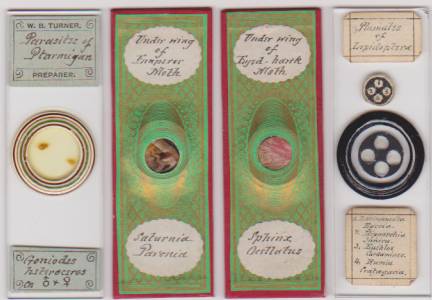
The multiple cell mount of butterfly plumules shows elaborate care and sophistication in preparation; Turner made several such slides.
The Turner/Walsingham friendship may have gone back a long way: below, I show some more slides made at Aldeby. The possible ongoing Norfolk connection is an intriguing one, but to date I have no more than the 1860 slides’ evidence for more than Yorkshire or Oxfordshire association between them, with their common interests in sport and insects. They certainly had a lengthy relationship in later years: Walsingham had land in Yorkshire, and was a leading light in the Yorkshire Naturalists' Union in Doncaster, ultimately becoming its president.
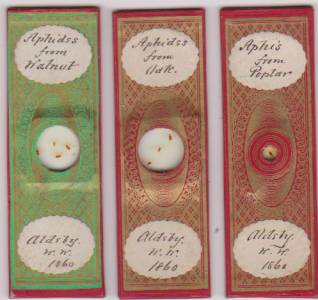
More Norfolk aphids
Settling in to family life in Leeds
Turner's first address, recorded in the members' list of the Leeds Naturalists' Club, was at 22 Northfield Square, Lovell Road, in an area known as "little London". He may have been renting there: the 1881 census shows him at 55 Reginald Terrace, with his wife Mary and two sons, William Barwell Turner aged 3 and Cecil Barwell Turner aged 1. The household also included a cook and a maidservant.
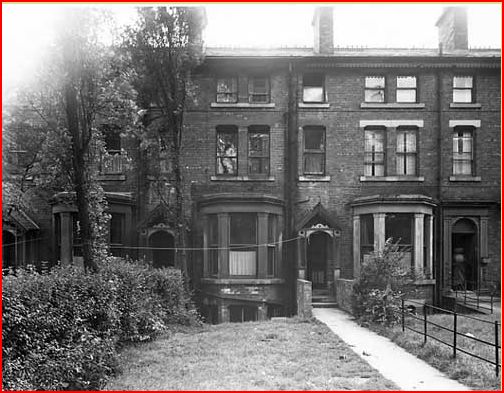
Reginald Terrace in Turner’s day: not grand houses, but comfortable, with space for a growing family and servants.
As well as front gardens, houses in Reginald Terrace had substantial back yards, enough for separate business premises – and certainly enough for Turner to set up a laboratory for his mounting activities, and chemical experiments, if he so wished.
Contributions to the chemical literature continued, but – judging by his large output of mounts – it was microscopy which now became his major preoccupation outside work. While many subjects continued to interest Turner, and are reflected in the mounts he made, as time passed his research focus became concentrated on fresh water algae, in particular desmids. In a further article I shall deal with many aspects of his life and work in Leeds.
Comments to the author will be welcomed.
Acknowledgements
Eveleigh and Michael Bradford, and Peter Meredith, of the Thoresby Society (Leeds) have been lavishly helpful with information.
Thanks also to David Walker for help in locating some of the chemical literature.
And a special thanks to Raymond Anderson for information on Allsopp & Sons.
Sources
B. Bracegirdle, Microscopical Mounts and Mounters (1998) p.95
Various chemical journals
Government Records Office (UK)
Yorkshire Weekly Post, 18 April 1916 & 19 May 1917
For John Nokes Furze, the fullest biography can be found in Brian Stevenson’s www.microscopist.net
Microscopy UK Front
Page
Micscape
Magazine
Article
Library
Published in the September 2011 edition of Micscape Magazine.
Please report any Web problems or offer general comments to the Micscape Editor .
Micscape is the on-line monthly magazine of the Microscopy UK website at Microscopy-UK .
© Onview.net Ltd, Microscopy-UK, and all contributors 1995 onwards. All rights reserved. Main site is at www.microscopy-uk.org.uk .